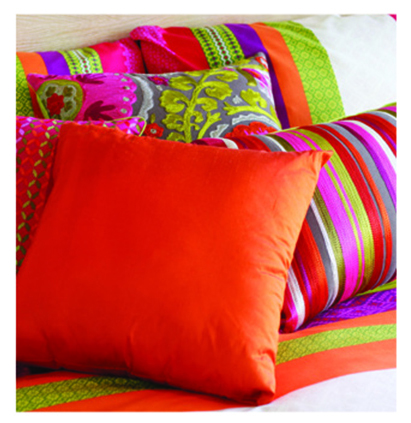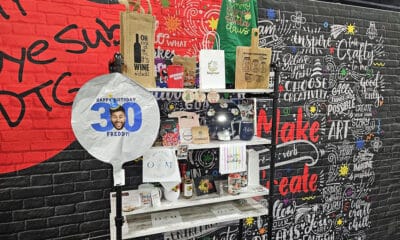Events
Published
8 years agoon

ITMA is the major international exhibition of the textile industry’s equipment, tools, and materials, and while it’s held just once every four years, its technologies are rapidly easing into both screen and digital printing markets. Held last November in Milan – the urban powerhouse of fashion and fabric – ITMA featured a global span of manufacturers and suppliers displaying the full range of textile machinery, innovations, and software.
ITMA is the major international exhibition of the textile industry’s equipment, tools, and materials, and while it’s held just once every four years, its technologies are rapidly easing into both screen and digital printing markets. Held last November in Milan – the urban powerhouse of fashion and fabric – ITMA featured a global span of manufacturers and suppliers displaying the full range of textile machinery, innovations, and software. The show’s breadth spanned designing, resource planning, spinning, weaving, knitting, embroidery, felting, recycling, printing, washing, steaming, dyeing, drying, cutting, finishing, workflow, and even transportation: In other words, an eyeful of textile technology. A range of single-pass technologies wowed the digital market, while cutting-edge advances in pigmented inks will impact both screen and digital printing segments in the months and years to come.
Inkjet Inks Versus Analog
Inkjet technology can print many of the same types of ink and fluid as conventional analog processes, but typically at significantly lower fluid viscosities and requiring much finer particulates for its pigmented inks. Both analog and digital fiber-reactive dyes decorate cellulosic fiber fabrics such as cotton, linen, and viscose rayon. They can also color protein fibers, including silk and wool.
How does this process work? First, remember that reactive dyes form very strong covalent chemical bonds with fibers. On the other hand, printers will often use acid dye inks to decorate protein fiber fabrics including silk, wool, and nylon. Protein fibers are more receptive to acids, and acid dyes offer the type of superior sheen on lustrous, silky fabrics that demanding customers require.
If you’re printing on synthetic media, direct-print disperse dyes and their sister sublimation transfer dyes offer an effective way to decorate polyester and some other man-made fibers. Polyester fibers, in particular, are receptive to disperse and sublimation dye penetration with the addition of heat and, for sublimation dye, pressure. Dyers and decorators of acrylic fabrics will use either disperse or cationic dyes. The strength of dye bonding methods varies according to the strength of these bonds between various inks and fabrics. Sublimation transfers and direct inkjet printing of polyester fabrics yield prints that pop and wash well, which is one reason for the slow adoption of non-polyester fabric media among inkjet users.
Why Pick Pigmented Inks?
Printed and fixed dye-based inks can produce vibrant color and soft hand. Most dyes, however, are vulnerable to fading when exposed to the UV energy in sunlight and the chemical effects of ozone and oxygen. Screen-printed pigmented inks lack the soft hand of dye-based inks, and typically have a heavier hand than inkjet pigmented systems. Pigmented inks generally yield much greater resistance to fading when exposed to sunlight, oxygen, and ozone than dye-based inks. Also they do not require washing to remove excess dye after heat setting, as direct dye printing typically does.
Of course, buyers of apparel fabrics generally prefer the soft hand and vibrancy of dye, even though such fabrics are prone to fading. On the other hand, buyers also prefer pigment printed fabrics when they are exposed to sunlight, as outdoor signage, curtains, some home furnishings, and even decorated T-shirts often are. Some manufacturers of inkjet inks have introduced pigmented inks with relatively soft hand while others have been developing UV-absorbing coatings to protect dye-based inks.
Which type of ink should a printer chose? Suppliers typically dedicate each of their textile inkjet devices to a particular ink type. This is because changing ink types can be a hassle, requiring significant downtime and material to flush and clean the printheads. For that same reason, some textile equipment OEMs now offer eight-color systems that permit two different four-color process ink systems on the same device.
ITMA’s New Ink Technologies
Kornit Digital presented its Allegro scanning head roll-to-roll inkjet textile printing and curing system, as well as its new Vulcan six-color plus white high-production inkjet direct-to-garment printer. The Vulcan reportedly can print light and dark garments at the same rate of 250 per hour using 60 Dimatix ink recirculation piezo inkjet (PIJ) heads. In addition, Kornit promoted its NeoPigment Pure process color inks that produce relatively soft hand, durable wash and crock fastness (according to my own wash test), and broad color gamut.
Bordeaux Digital Print Ink introduced its Velvet Jet pigmented process color textile inks as a universal ink set for all fabrics. The company claims that its inks are compatible for industrial PIJ heads from Ricoh, Konica Minolta, Kyocera, Fujifilm Dimatix, Seiko, Toshiba, and Epson. Its brochure lists compatible print substrates including:
• Cotton and cotton blends;
• Viscose rayon;
• Leather;
• Synthetic leather;
• Lycra;
• Silk;
• Polyester;
• Polyamide (nylon);
• And mixed synthetic fabrics.
Velvet Jet promotes the inks for use on furniture, home textiles, garments, accessories, sports apparel, and footwear. I spoke with Thomas Poetz, business development director for Velvet Jet, who provided me with print samples and the company’s published record of ISO 105 fastness test results for each of Velvet Jet’s process color inks printed on 100-percent polyester and 100-percent cotton fabrics. According to test results, the prints on both fabrics exhibited the test standards’ highest level of light- and wash-fastness for all four process colors. Printed on treated 100-percent cotton, they scored of a 4 out of 5 for dry- and wet-rub fastness. Printed on 100-percent polyester, the inks scored 3 to 4 on untreated fabric and 4 to 5 on treated. Velvet Jet recommends drying fabrics printed with its inks at 150 degrees C (302 degrees F) for three minutes. It claims up to 12 months of outdoor durability.
Mark Sawchak, of Expand Systems, US distributor for the MS line of textile printers, said that his company now has pigmented inks. In addition to its inkjet dye-based devices, MS displayed its other scanning head inkjet textile systems printing pigmented and disperse dye inks onto fabric and dye-sublimation inks to transfer paper.
Still, not every manufacturer is pursuing pigment. At ITMA, Jos Notermans, commercial manager for digital textiles at SPGPrints, said his company is focusing on dye-based inks because of the recent development of its Pike single-pass printer and the scanning head inkjet systems it sells. SPG developers created reactive dye inks for printing cellulosic natural fibers, such as cotton and linen, which the company says represent 70 percent of the textile market for digital printing. While the Fujifilm Dimatix PIJ Samba heads used in the Pike recirculate their ink through each printhead, theoretically enabling pigment printing reliability, Notermans did not see opportunities in markets that use pigments, such as home furnishings.
And so, for pigment inks, as with so many other technologies disrupting our industry today, the potential for high-performance output must be weighed against the twin constraints of cost and adoption. But don’t be surprised to see pigment inks popping up with increasing frequency as we move through 2016. Like the colors they express, these products stand little chance of fading away.
Read more on "How Pigments Prevent Fading" or check out our February/March issue.

Subscribe

Magazine
Get the most important news
and business ideas from Screenprinting Magazine.
Most Popular
-

 Case Studies2 months ago
Case Studies2 months agoHigh-Density Inks Help Specialty Printing Take Center Stage
-

 Art, Ad, or Alchemy2 months ago
Art, Ad, or Alchemy2 months agoF&I Printing Is Everywhere!
-

 Andy MacDougall2 months ago
Andy MacDougall2 months agoFunctional and Industrial Printing is EVERYWHERE!
-

 Columns3 weeks ago
Columns3 weeks ago8 Marketing Mistakes Not to Make When Promoting Your Screen Printing Services Online
-

 Editor's Note3 weeks ago
Editor's Note3 weeks agoLivin’ the High Life
-

 Marshall Atkinson3 weeks ago
Marshall Atkinson3 weeks agoHow to Create a Winning Culture in Your Screen-Printing Business
-

 Thomas Trimingham2 months ago
Thomas Trimingham2 months ago“Magic” Marketing for Screen Printing Shops
-

 Case Studies3 weeks ago
Case Studies3 weeks agoScreen Printing for Texture and Depth






